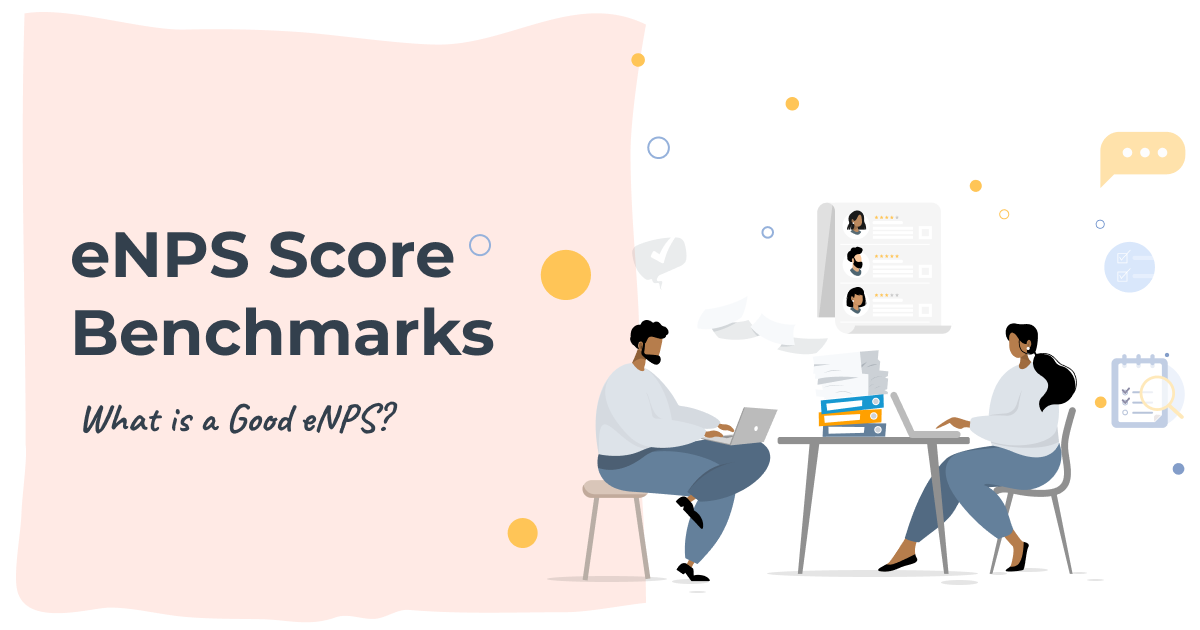eNPS (or employee Net Promoter Score) is a quick way to gauge the satisfaction level of employees in an organization. We’ve talked in the past about how to get maximum value out of eNPS, and now we’ll cover eNPS score benchmarks.
David Meltzer, CEO of East Insurance Group, says: “Employee Net Promoter Score is a measure of how likely your staff members are to recommend your company as a place to work through surveys. Surveys are unbiased and can provide insight towards a company without any outside interference and will show only the truth, that is why it is a good measure for employee engagement.”
eNPS score benchmarking can be a complicated process. Scoring can look different across industries, organization types, and professions. There are several factors that influence each metric over time.
Why is eNPS score a good way to measure employee engagement?
eNPS has risen in popularity largely thanks to its simplicity and efficient way of surveying employees. It can measure things like employee engagement levels, intent to remain with the company, and motivation to do their work in the job, all in a short time frame that won’t give employees survey fatigue.
Michael Hamelburger, CEO of Expense Reduction Group said, “if entrepreneurs are too concerned with the Voice of the Customer, they should also look into the Voice of the Employee to uncover important insights from the data they mine and can be influential in their decision-making process for the organization. Using data such as eNPS and making valuable insights can create a deeper engagement with the staff.”

Reflections from an HR expert
eNPS scores eliminate the need for organizations to send out lengthy employee satisfaction surveys and instead swap those for frequent, quick surveys that employees can complete in just minutes.
What is really a good eNPS score?
An eNPS score benchmark can be difficult because what determines a good score is largely relative. For example, department stores tend to have higher eNPS scores than banks and insurance companies. We recommend doing some research in your industry, for different professions, and even geographical regions to first understand what a “normal” score is.
Jennifer Willy, Editor at Etia.com says, “if your company is resorting to measuring eNPS then it is going on the right path to identifying dissatisfaction at their workplace. According to experts, the range of the score can be anywhere from -100 to 100 but anything above zero is generally acceptable. Different companies and organizations have different standards and benchmarks to measure their performances. But generally, a score between 10-30 is considered good while anything near 50 is excellent.”
Some markets may never get an eNPS score of more than 20, and that’s okay. Always be sure to acquire the eNPS scores of your competitors, as it is a good measure for knowing where your organization stands. This is also known as the “relative method.” It involves benchmarking your eNPS score to the current standard in the industry.
Global NPS & eNPs benchmark report by www.relationwise.com
How do you benchmark with eNPS?
Basically, the baseline score itself that your company earns should not be the only place you start the eNPS score benchmark from. An in-depth competitive analysis should be part of that process so you know where your company is strong versus weak in employee engagement when you begin these measurements.
From there, continue to benchmark eNPS against that original number over 3-6 months. If there is an increase, you will know you’re moving in the right direction. If the same number remains or there is a decrease, you know you need to make improvements. You also want to implement a regular survey cadence to ensure more clear benchmark results.
Consider the survey channel
The channel in which you conduct the survey can impact the eNPS score benchmark. Whether it’s carried out via email, an app, SMS, paper, phone call, or online form, some channels may perform better than others.
Web-based surveys are held in high esteem by many enterprises. Heartpace Pulse is an incredibly quick and easy way to survey employees. Also, it will automatically track the progress of eNPS score benchmarks with precision.

Browse our webinar library!
We have a number of webinars about different HR related topics available to watch whenever you want.
How do you drive higher eNPS scores after the benchmark?
No matter what, you will want to do your best to keep your NPS above 0—below that is an indication your business has many problems to fix. In your niche/industry, even if -10 is the norm, you won’t want to find your company consistently performing below 0. It’s also a good incentive to aim higher than competitors.
Want to inspire higher eNPS scores across the organization? Learn to do the following:
- Take the time to look through, read and understand the needs of your employees
- Use the data garnered from the surveys to continually look at which areas with low scores specifically need improvement.
- In an age of customization, try customizing employees personal interests, goals, and needs. A one-size-fits-all solution will no longer work for employee satisfaction.
Looking to get started with your eNPS scores and start your benchmark? Use one of our free employee survey templates today. You can also contact us to learn more about what Heartpace software can do for eNPS score benchmarks at your organization.

Do you want to see more?
Book a demo here to see Heartpace HR system
Explore more posts
Want to keep updated?
Subscribe to our blog posts, news and webinars here. We promise that we won’t overwhelm you with emails, nor will we never ever give your email address to anyone else!








